2013 YAMAHA YZ125LC clutch
[x] Cancel search: clutchPage 33 of 168
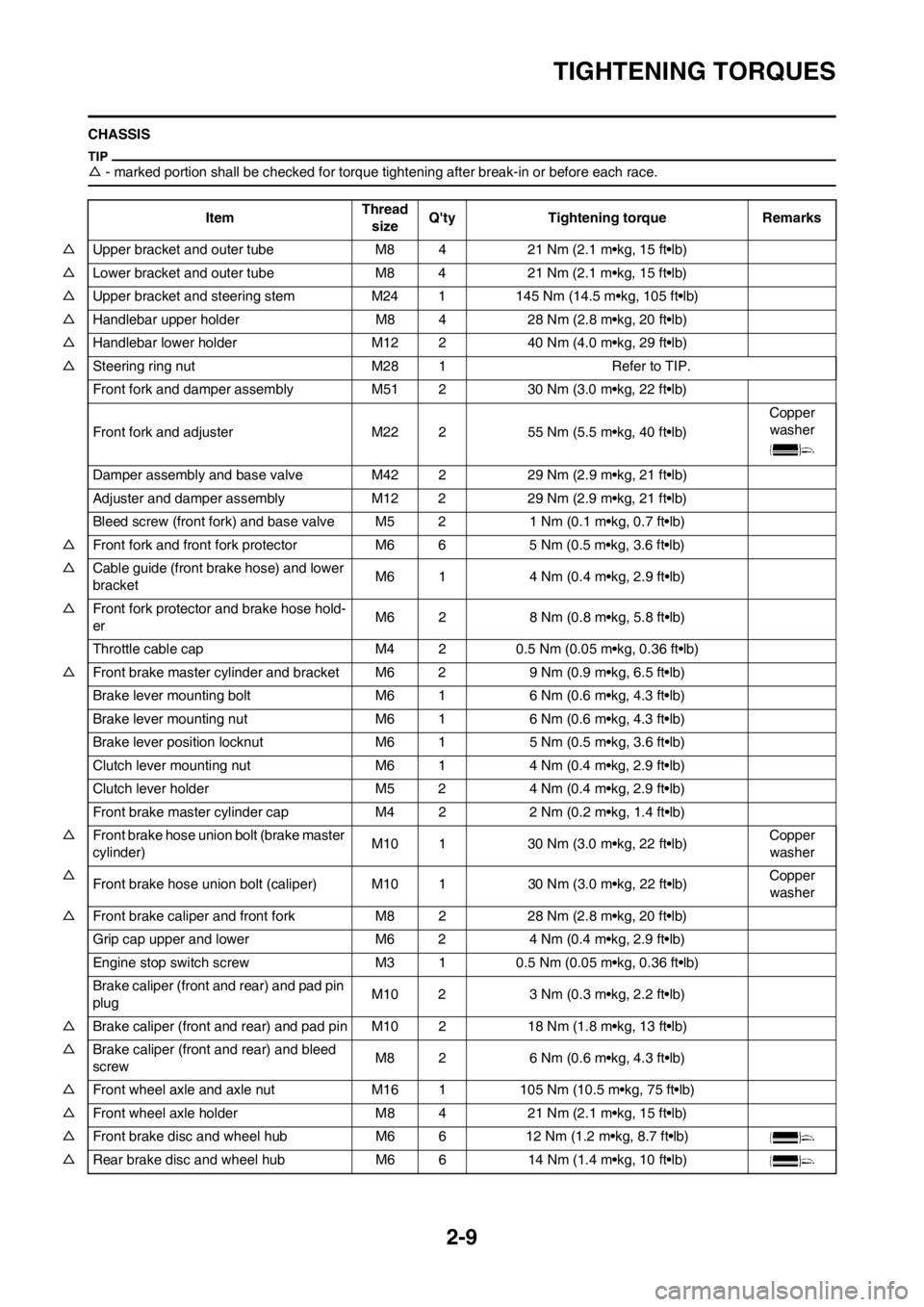
2-9
TIGHTENING TORQUES
CHASSIS
△- marked portion shall be checked for torque tightening after break-in or before each race.
ItemThread
sizeQ'ty Tightening torque Remarks
△Upper bracket and outer tube M84 21 Nm (2.1 m•kg, 15 ft•lb)
△Lower bracket and outer tube M8 4 21 Nm (2.1 m•kg, 15 ft•lb)
△Upper bracket and steering stem M24 1 145 Nm (14.5 m•kg, 105 ft•lb)
△Handlebar upper holder M8 4 28 Nm (2.8 m•kg, 20 ft•lb)
△Handlebar lower holder M12 2 40 Nm (4.0 m•kg, 29 ft•lb)
△Steering ring nut M28 1 Refer to TIP.
Front fork and damper assembly M51 2 30 Nm (3.0 m•kg, 22 ft•lb)
Front fork and adjuster M22 2 55 Nm (5.5 m•kg, 40 ft•lb)Copper
washer
Damper assembly and base valve M42 2 29 Nm (2.9 m•kg, 21 ft•lb)
Adjuster and damper assembly M12 2 29 Nm (2.9 m•kg, 21 ft•lb)
Bleed screw (front fork) and base valve M5 2 1 Nm (0.1 m•kg, 0.7 ft•lb)
△Front fork and front fork protector M6 6 5 Nm (0.5 m•kg, 3.6 ft•lb)
△Cable guide (front brake hose) and lower
bracketM6 1 4 Nm (0.4 m•kg, 2.9 ft•lb)
△Front fork protector and brake hose hold-
erM6 2 8 Nm (0.8 m•kg, 5.8 ft•lb)
Throttle cable cap M4 2 0.5 Nm (0.05 m•kg, 0.36 ft•lb)
△Front brake master cylinder and bracket M6 2 9 Nm (0.9 m•kg, 6.5 ft•lb)
Brake lever mounting bolt M6 1 6 Nm (0.6 m•kg, 4.3 ft•lb)
Brake lever mounting nut M6 1 6 Nm (0.6 m•kg, 4.3 ft•lb)
Brake lever position locknut M6 1 5 Nm (0.5 m•kg, 3.6 ft•lb)
Clutch lever mounting nut M6 1 4 Nm (0.4 m•kg, 2.9 ft•lb)
Clutch lever holder M5 2 4 Nm (0.4 m•kg, 2.9 ft•lb)
Front brake master cylinder cap M4 2 2 Nm (0.2 m•kg, 1.4 ft•lb)
△Front brake hose union bolt (brake master
cylinder)M10 1 30 Nm (3.0 m•kg, 22 ft•lb)Copper
washer
△
Front brake hose union bolt (caliper) M10 1 30 Nm (3.0 m•kg, 22 ft•lb)Copper
washer
△Front brake caliper and front fork M8 2 28 Nm (2.8 m•kg, 20 ft•lb)
Grip cap upper and lower M6 2 4 Nm (0.4 m•kg, 2.9 ft•lb)
Engine stop switch screw M3 1 0.5 Nm (0.05 m•kg, 0.36 ft•lb)
Brake caliper (front and rear) and pad pin
plugM10 2 3 Nm (0.3 m•kg, 2.2 ft•lb)
△Brake caliper (front and rear) and pad pin M10 2 18 Nm (1.8 m•kg, 13 ft•lb)
△Brake caliper (front and rear) and bleed
screwM8 2 6 Nm (0.6 m•kg, 4.3 ft•lb)
△Front wheel axle and axle nut M16 1 105 Nm (10.5 m•kg, 75 ft•lb)
△Front wheel axle holder M8 4 21 Nm (2.1 m•kg, 15 ft•lb)
△Front brake disc and wheel hub M6 6 12 Nm (1.2 m•kg, 8.7 ft•lb)
△Rear brake disc and wheel hub M6 6 14 Nm (1.4 m•kg, 10 ft•lb)
Page 38 of 168
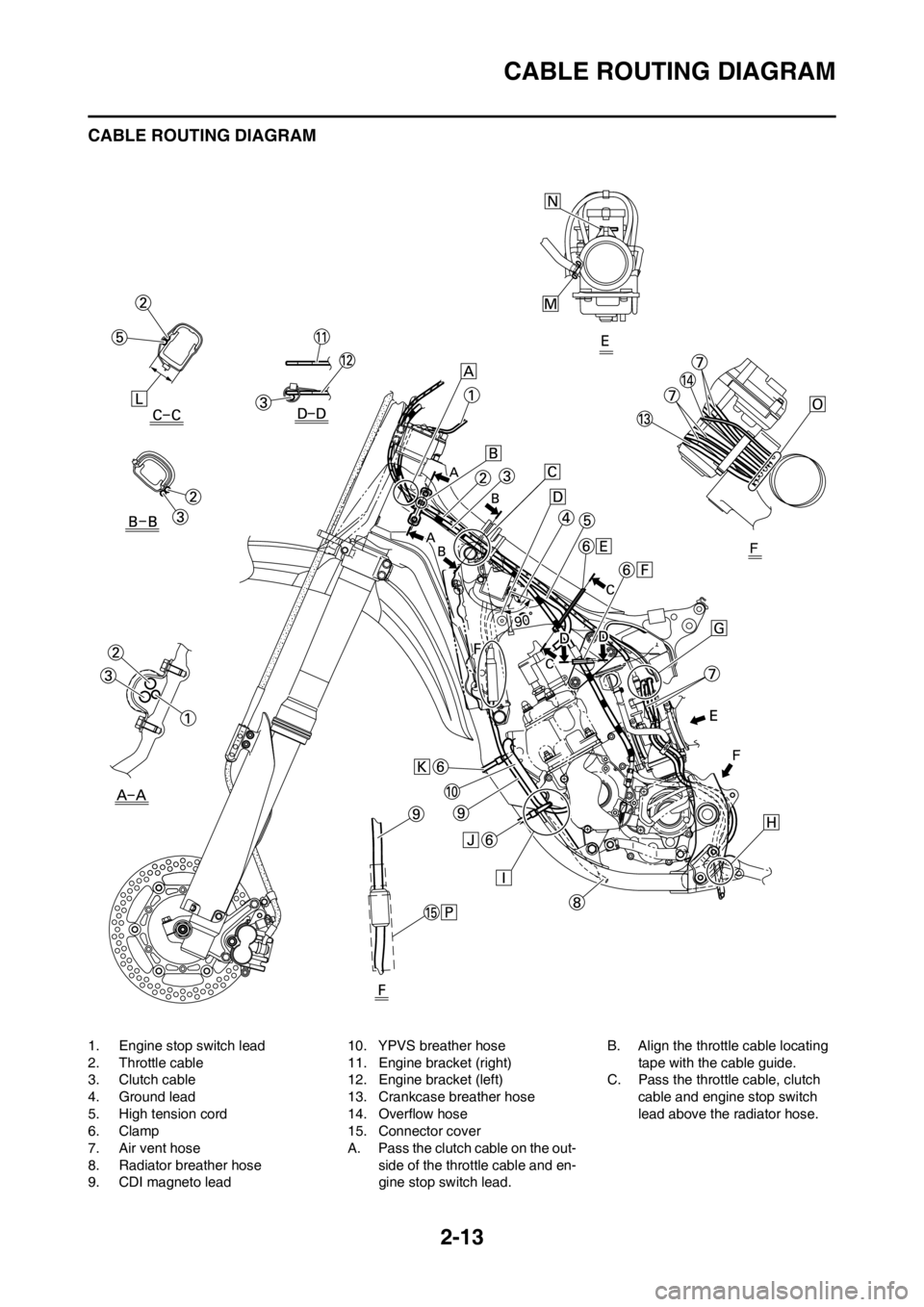
2-13
CABLE ROUTING DIAGRAM
CABLE ROUTING DIAGRAM
1. Engine stop switch lead
2. Throttle cable
3. Clutch cable
4. Ground lead
5. High tension cord
6. Clamp
7. Air vent hose
8. Radiator breather hose
9. CDI magneto lead10. YPVS breather hose
11. Engine bracket (right)
12. Engine bracket (left)
13. Crankcase breather hose
14. Overflow hose
15. Connector cover
A. Pass the clutch cable on the out-
side of the throttle cable and en-
gine stop switch lead.B. Align the throttle cable locating
tape with the cable guide.
C. Pass the throttle cable, clutch
cable and engine stop switch
lead above the radiator hose.
Page 39 of 168

2-14
CABLE ROUTING DIAGRAM
D. Install the ignition coil, side core
and ground lead together to the
frame. Take care to fasten the
ground lead so that its terminal
is within the indicated range.
E. Clamp the throttle cable and
high tension cord to the frame.
F. Clamp the clutch cable to the left
engine bracket. Clamp the
clutch cable below the position-
ing grommet.
G. Pass the air vent hose back of
the throttle cable.
H. Pass the air vent hose, overflow
hose and crankcase breather
hose between the frame and
connecting rod.
I. Pass the radiator breather hose
and YPVS breather hose out-
side the engine bracket and in-
side the down tube. Then pass
the radiator breather hose inside
the YPVS breather hose.
J. Clamp the CDI magneto lead,
radiator breather hose and
YPVS breather hose to the
frame.
K. Clamp to the frame the CDI
magneto lead and radiator
breather hose. Take care to
clamp them above the projection
on the frame.
L. Locate the clamp ends in the ar-
rowed range.
M. Direct the clip with its finger grip
facing forward.
N. Tighten the clamp with its bolt
head facing the left side of the
chassis (on both sides of the
carburetor joint and the air filter
joint).
O. Pass the air vent hose, overflow
hose and crankcase breather
hose so that they do not contact
the rear shock absorber.
P. Bring the connector cover into
contact with the coupler.
Page 40 of 168
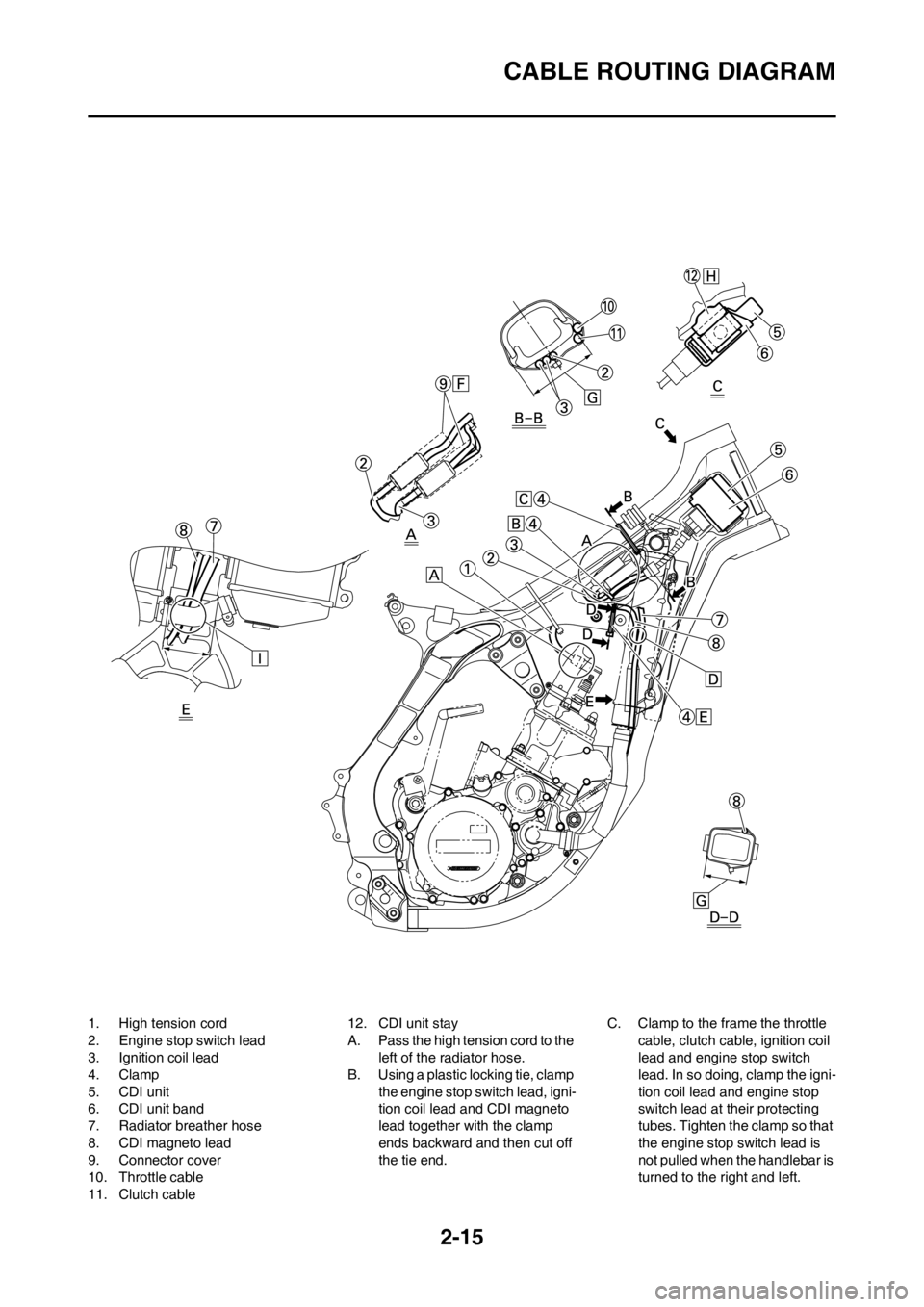
2-15
CABLE ROUTING DIAGRAM
1. High tension cord
2. Engine stop switch lead
3. Ignition coil lead
4. Clamp
5. CDI unit
6. CDI unit band
7. Radiator breather hose
8. CDI magneto lead
9. Connector cover
10. Throttle cable
11. Clutch cable12. CDI unit stay
A. Pass the high tension cord to the
left of the radiator hose.
B. Using a plastic locking tie, clamp
the engine stop switch lead, igni-
tion coil lead and CDI magneto
lead together with the clamp
ends backward and then cut off
the tie end.C. Clamp to the frame the throttle
cable, clutch cable, ignition coil
lead and engine stop switch
lead. In so doing, clamp the igni-
tion coil lead and engine stop
switch lead at their protecting
tubes. Tighten the clamp so that
the engine stop switch lead is
not pulled when the handlebar is
turned to the right and left.
Page 43 of 168
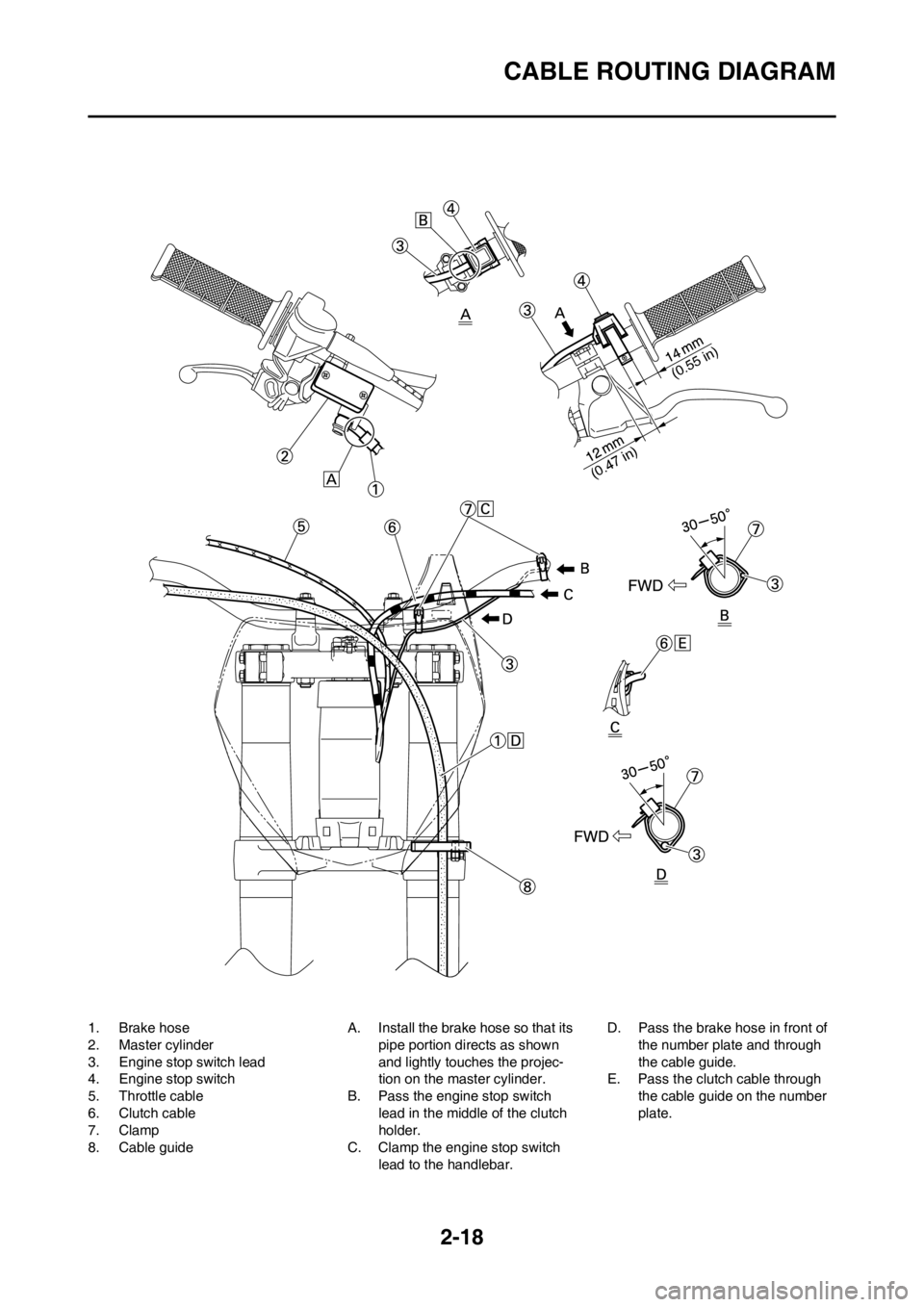
2-18
CABLE ROUTING DIAGRAM
1. Brake hose
2. Master cylinder
3. Engine stop switch lead
4. Engine stop switch
5. Throttle cable
6. Clutch cable
7. Clamp
8. Cable guideA. Install the brake hose so that its
pipe portion directs as shown
and lightly touches the projec-
tion on the master cylinder.
B. Pass the engine stop switch
lead in the middle of the clutch
holder.
C. Clamp the engine stop switch
lead to the handlebar.D. Pass the brake hose in front of
the number plate and through
the cable guide.
E. Pass the clutch cable through
the cable guide on the number
plate.
(0.55 in)
(0.47 in)
Page 44 of 168
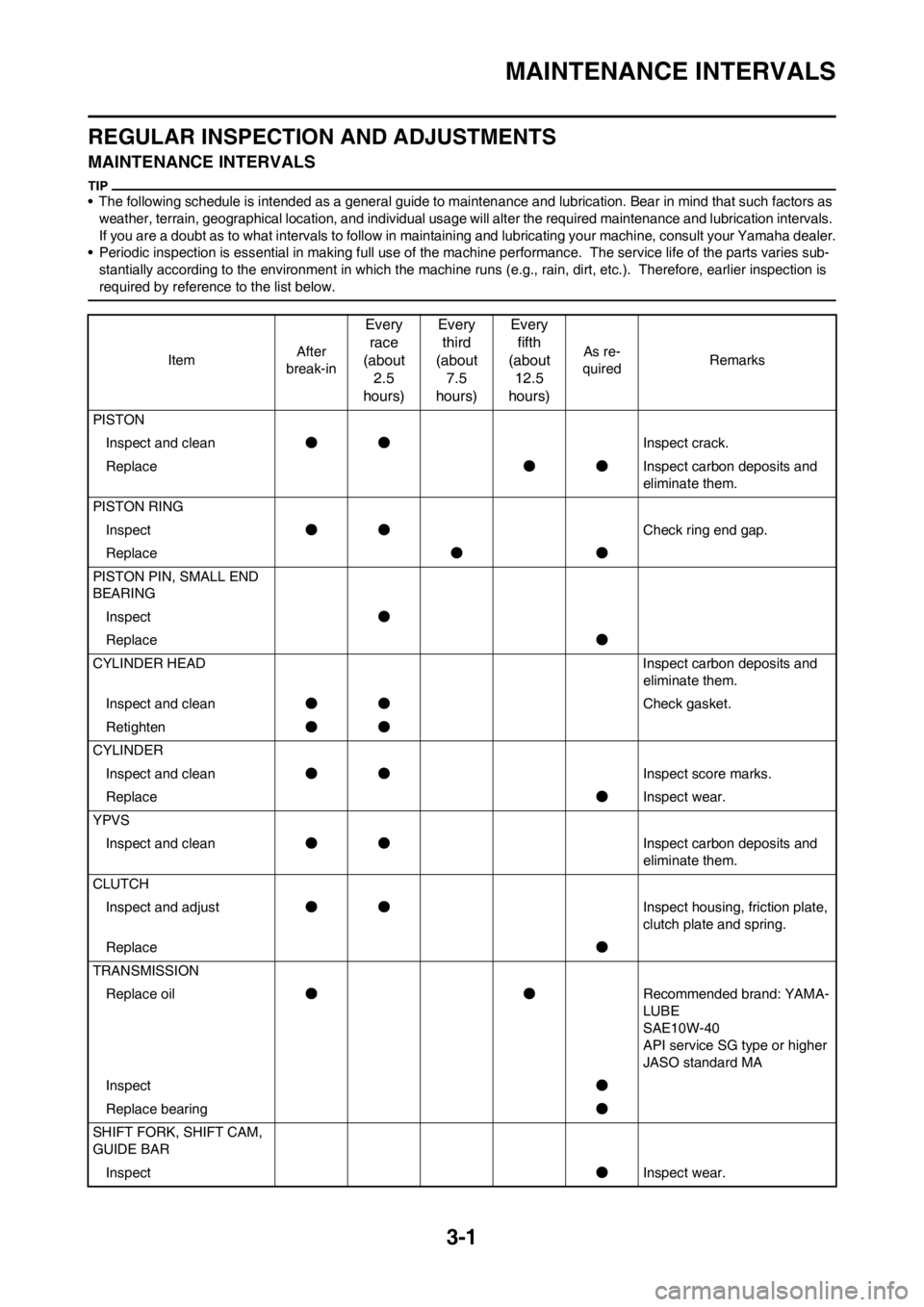
3-1
MAINTENANCE INTERVALS
REGULAR INSPECTION AND ADJUSTMENTS
MAINTENANCE INTERVALS
• The following schedule is intended as a general guide to maintenance and lubrication. Bear in mind that such factors as
weather, terrain, geographical location, and individual usage will alter the required maintenance and lubrication intervals.
If you are a doubt as to what intervals to follow in maintaining and lubricating your machine, consult your Yamaha dealer.
• Periodic inspection is essential in making full use of the machine performance. The service life of the parts varies sub-
stantially according to the environment in which the machine runs (e.g., rain, dirt, etc.). Therefore, earlier inspection is
required by reference to the list below.
ItemAfter
break-in
Every
race
(about
2.5
hours)Every
third
(about
7.5
hours)Every
fifth
(about
12.5
hours)
As re-
quiredRemarks
PISTON
Inspect and clean●●Inspect crack.
Replace●●Inspect carbon deposits and
eliminate them.
PISTON RING
Inspect●●Check ring end gap.
Replace●●
PISTON PIN, SMALL END
BEARING
Inspect●
Replace●
CYLINDER HEAD Inspect carbon deposits and
eliminate them.
Inspect and clean●●Check gasket.
Retighten●●
CYLINDER
Inspect and clean●●Inspect score marks.
Replace●Inspect wear.
YPVS
Inspect and clean●●Inspect carbon deposits and
eliminate them.
CLUTCH
Inspect and adjust●●Inspect housing, friction plate,
clutch plate and spring.
Replace●
TRANSMISSION
Replace oil●●Recommended brand: YAMA-
LUBE
SAE10W-40
API service SG type or higher
JASO standard MA
Inspect●
Replace bearing●
SHIFT FORK, SHIFT CAM,
GUIDE BAR
Inspect●Inspect wear.
Page 48 of 168

3-5
PRE-OPERATION INSPECTION AND MAINTENANCE
PRE-OPERATION INSPECTION AND MAINTENANCE
Before riding for break-in operation, practice or a race, make sure the machine is in good operating condition.
Before using this machine, check the following points.
GENERAL INSPECTION AND MAINTENANCE
Item Routine Page
CoolantCheck that coolant is filled up to the radiator cap. Check the cool-
ing system for leakage.P.3-6 – 7
FuelCheck that a fresh mixture of oil and gasoline is filled in the fuel
tank. Check the fuel line for leakage.P.1-12
Transmission oilCheck that the oil level is correct. Check the crankcase for leak-
age.P.3-8 – 9
Gear shifter and clutchCheck that gears can be shifted correctly in order and that the
clutch operates smoothly.P.3-7
Throttle grip/HousingCheck that the throttle grip operation and free play are correctly
adjusted. Lubricate the throttle grip and housing, if necessary.P.3-7 – 8
Brakes Check the play of front brake and effect of front and rear brake. P.3-9 – 12
Drive chainCheck drive chain slack and alignment. Check that the drive chain
is lubricated properly.P.3-12 – 13
WheelsCheck for excessive wear and tire pressure. Check for loose
spokes and have no excessive play.P.3-16 – 17
SteeringCheck that the handlebar can be turned smoothly and have no ex-
cessive play.P.3-17
Front forks and rear shock
absorberCheck that they operate smoothly and there is no oil leakage.
P.3-13 – 16
Cables (wires)Check that the clutch and throttle cables move smoothly. Check
that they are not caught when the handlebars are turned or when
the front forks travel up and down.—
Muffler Check that the muffler is tightly mounted and has no cracks. P.4-3 – 4
Rear wheel sprocket Check that the rear wheel sprocket tightening bolt is not loose. P.3-12
Lubrication Check for smooth operation. Lubricate if necessary. P.3-18
Bolts and nuts Check the chassis and engine for loose bolts and nuts. P.1-13
Lead connectorsCheck that the CDI magneto, CDI unit, and ignition coil are con-
nected tightly.P.1-7
SettingsIs the machine set suitably for the condition of the racing course
and weather or by taking into account the results of test runs be-
fore racing? Are inspection and maintenance completely done?P.7-1 – 11
Page 50 of 168
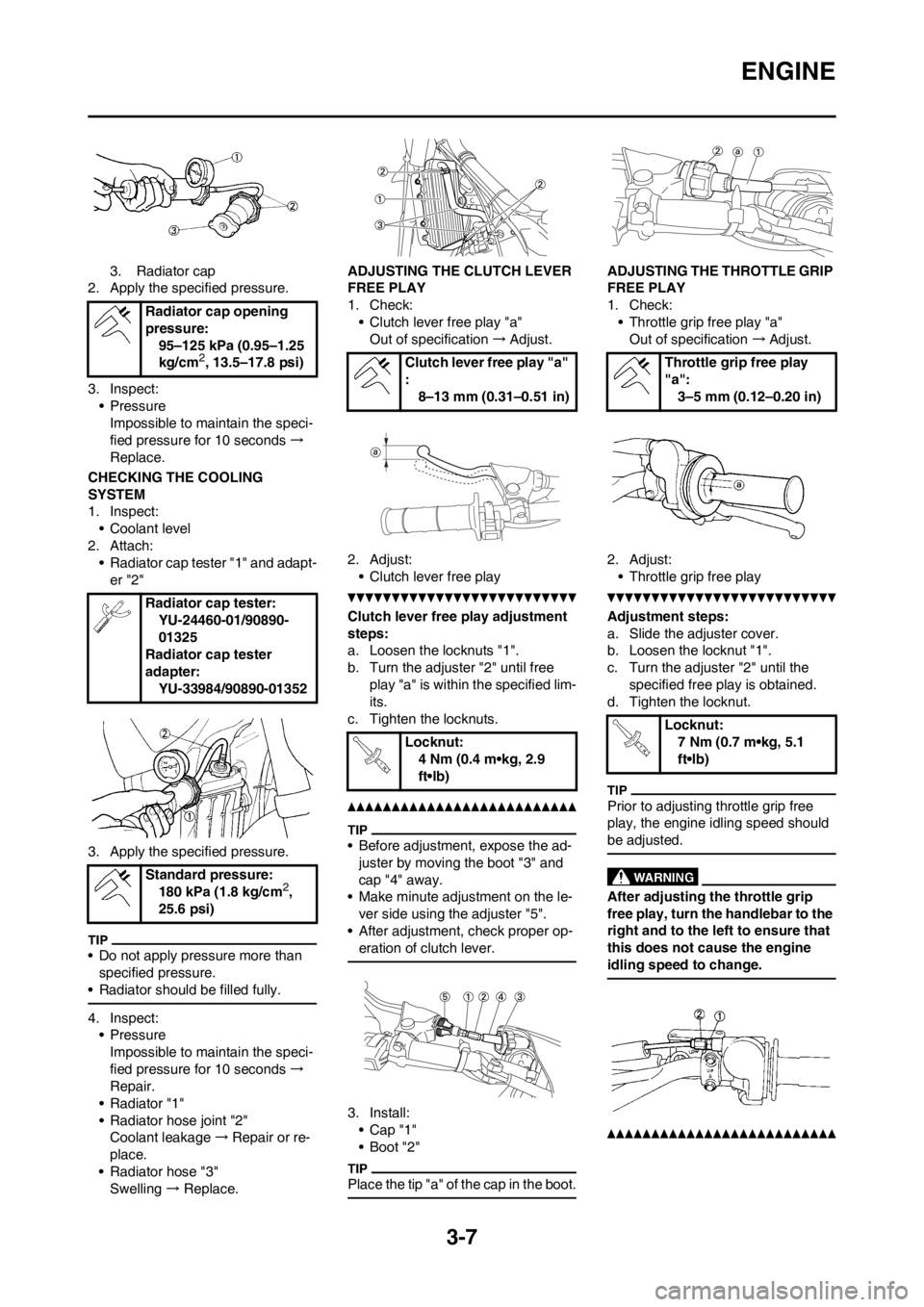
3-7
ENGINE
3. Radiator cap
2. Apply the specified pressure.
3. Inspect:
• Pressure
Impossible to maintain the speci-
fied pressure for 10 seconds →
Replace.
CHECKING THE COOLING
SYSTEM
1. Inspect:
• Coolant level
2. Attach:
• Radiator cap tester "1" and adapt-
er "2"
3. Apply the specified pressure.
• Do not apply pressure more than
specified pressure.
• Radiator should be filled fully.
4. Inspect:
• Pressure
Impossible to maintain the speci-
fied pressure for 10 seconds →
Repair.
•Radiator "1"
• Radiator hose joint "2"
Coolant leakage →Repair or re-
place.
• Radiator hose "3"
Swelling → Replace. ADJUSTING THE CLUTCH LEVER
FREE PLAY
1. Check:
• Clutch lever free play "a"
Out of specification →Adjust.
2. Adjust:
• Clutch lever free play
Clutch lever free play adjustment
steps:
a. Loosen the locknuts "1".
b. Turn the adjuster "2" until free
play "a" is within the specified lim-
its.
c. Tighten the locknuts.
• Before adjustment, expose the ad-
juster by moving the boot "3" and
cap "4" away.
• Make minute adjustment on the le-
ver side using the adjuster "5".
• After adjustment, check proper op-
eration of clutch lever.
3. Install:
• Cap "1"
•Boot "2"
Place the tip "a" of the cap in the boot.
ADJUSTING THE THROTTLE GRIP
FREE PLAY
1. Check:
• Throttle grip free play "a"
Out of specification →Adjust.
2. Adjust:
• Throttle grip free play
Adjustment steps:
a. Slide the adjuster cover.
b. Loosen the locknut "1".
c. Turn the adjuster "2" until the
specified free play is obtained.
d. Tighten the locknut.
Prior to adjusting throttle grip free
play, the engine idling speed should
be adjusted.
After adjusting the throttle grip
free play, turn the handlebar to the
right and to the left to ensure that
this does not cause the engine
idling speed to change.
Radiator cap opening
pressure:
95–125 kPa (0.95–1.25
kg/cm
2, 13.5–17.8 psi)
Radiator cap tester:
YU-24460-01/90890-
01325
Radiator cap tester
adapter:
YU-33984/90890-01352
Standard pressure:
180 kPa (1.8 kg/cm
2,
25.6 psi)
Clutch lever free play "a"
:
8–13 mm (0.31–0.51 in)
Locknut:
4 Nm (0.4 m•kg, 2.9
ft•lb)Throttle grip free play
"a":
3–5 mm (0.12–0.20 in)
Locknut:
7 Nm (0.7 m•kg, 5.1
ft•lb)